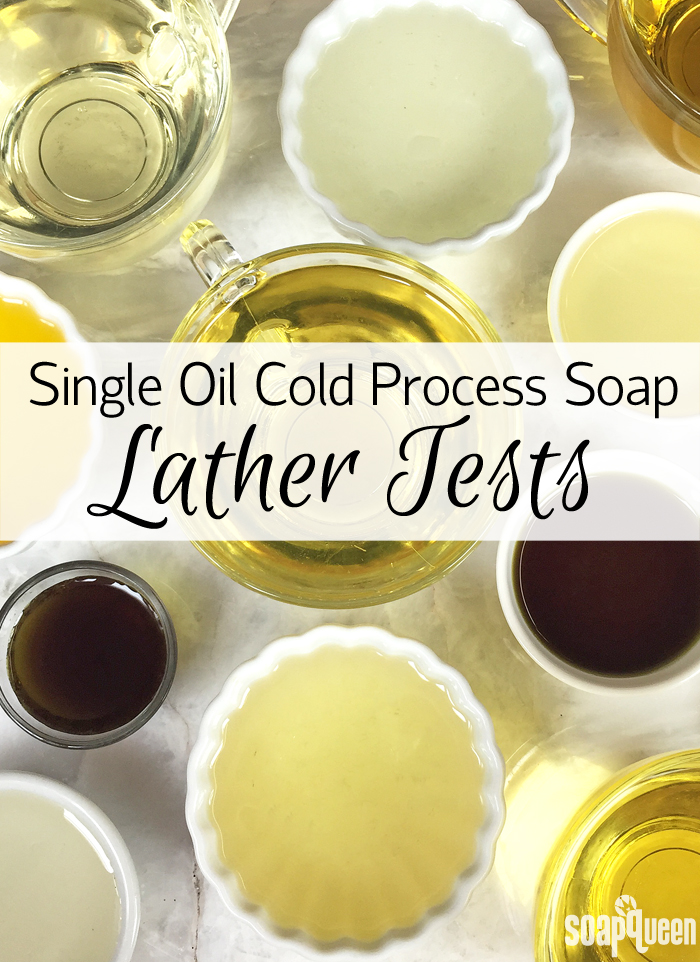
The most fundamental way that cold process soap can be customized is by using various combinations of soapmaking oils and butters. Each oil contributes something different to the final bar. For example, coconut oil is known for giving soap cleansing properties with a large fluffy lather. Olive oil, on the other hand, is not very cleansing, but is gentle on the skin. Using different combinations of oils at different usage rates will greatly affect the finished product. If you’d like to learn more about the properties of each soapmaking oil, check out this blog post.
Cold process soap can be made with only one oil, such as castile soap, which usually refers to soap made with 100% olive oil. Soap made with 100% olive oil is extremely gentle, but the lather is very minimal and it may initially be a softer bar. When soap is only made with one oil it may not be the most balanced bar. By adding coconut oil to the recipe, you give the bar cleansing properties. Each oil contributes something different to create a more balanced bar; this is why most cold process recipes are made with 3-6 different oils and butters. Check out the Formulating Cold Process Recipe post for more information on creating recipes, and the How to Substitute Oil in Cold Process Recipes post to learn how to swap them in existing recipes.
To take a closer look at how various oils and butters change the final bar, I created twelve bars made with 100% of one oil. Then, I let the soaps cure for a full six weeks. After they were done curing, I tested their lather. I also took note of how hard the bar was, how my skin felt after use and any other interesting characteristic.
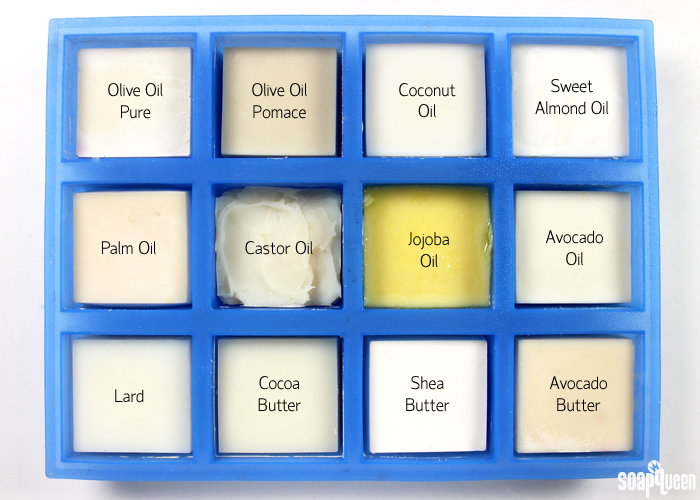
A Look into the Process
To make each bar of 100% oil soap, a lot of oil, lye and water needed to be prepped. Each batch used 5 ounces of the oil or butter with a 0% superfat. Each batch was poured into two cavities of the 12 Bar Square Silicone Mold. No sodium lactate was used in the bars. I tried to soap with my lye and oils as close to 120 º F as possible. Once poured, the bars were not insulated or placed on a heating pad. They were left at room temperature and sprayed with 99% isopropyl alcohol to prevent soda ash.
It’s interesting to look at the lye amount in each batch; the amount of lye is surprisingly similar. Each batch called for 1.65 ounces of water and was not water discounted. You can see the recipe for each batch below.
| Oil | Sodium Hydroxide Lye | Distilled Water | Yields | |
| Coconut Oil | 5 oz. | 0.89 oz. | 1.65 oz. | 7.54 oz. |
| Palm Oil | 5 oz. | 0.72 oz. | 1.65 oz. | 7.37 oz. |
| Olive Oil Pure | 5 oz. | 0.67 oz. | 1.65 oz. | 7.32 oz |
| Olive Oil Pomace | 5 oz. | 0.67 oz. | 1.65 oz. | 7.32 oz. |
| Castor Oil | 5 oz. | 0.675 oz. | 1.65 oz. | 7.33 oz. |
| Lard | 5 oz. | 0.69 oz. | 1.65 oz. | 7.34 oz. |
| Avocado Oil | 5 oz. | 0.665 oz. | 1.65 oz. | 7.32 oz. |
| Sweet Almond Oil | 5 oz. | 0.67 oz. | 1.65 oz. | 7.32 oz. |
| Shea Butter | 5 oz. | 0.665 oz. | 1.65 oz. | 7.32 oz. |
| Avocado Butter | 5 oz. | 0.665 oz. | 1.65 oz. | 7.32 oz. |
| Cocoa Butter | 5 oz. | 0.685 oz. | 1.65 oz. | 7.34 oz. |
| Jojoba Oil | 5 oz. | 0.345 oz. | 1.65 oz. | 7 oz |
For the majority of the oils, they traced and behaved like you would expect. The soft oils (olive oil pure/pomace, avocado oil and sweet almond oil) took longer to reach a trace than the hard oils (coconut oil, shea butter, avocado butter, cocoa butter). The one “hard” oil/butter that really surprised me was lard. I was expecting it to trace fairly quickly, but it took just as long as sweet almond or avocado. I’ve heard that trace and lard can be affected by the processing method for the lard.
The two oils that gave me those most trouble were castor oil and jojoba oil. Castor oil is a liquid oil that’s extracted from the Castor Bean Plant. It has a thick and rather sticky consistency. The 100% castor oil soap traced quickly, and the batter had an extremely thick, sticky and slimy consistency. After placing the castor oil batter into the mold, it was firm within the hour!
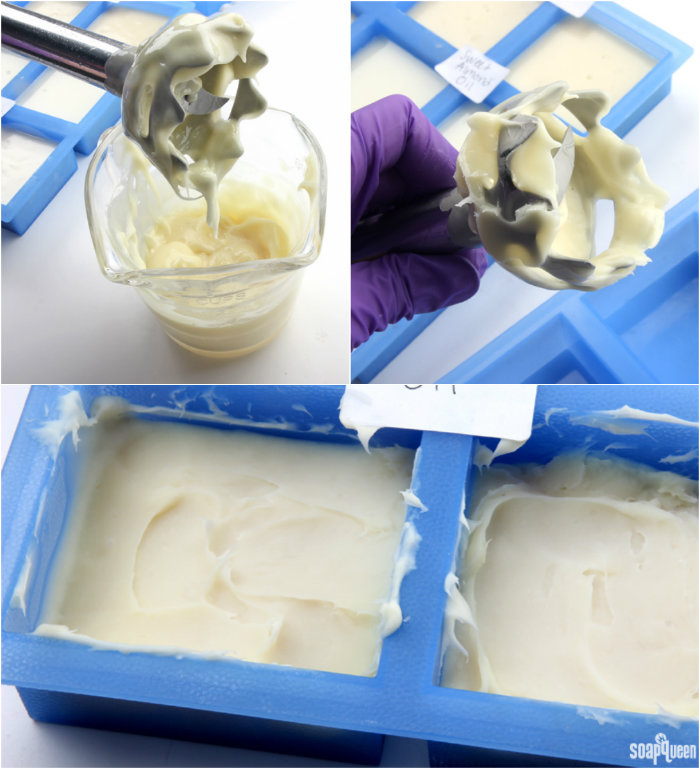 Making soap with 100% castor oil resulted in a very thick and sticky soap batter!
Making soap with 100% castor oil resulted in a very thick and sticky soap batter!
Jojoba oil was another oil that gave me some trouble, which makes sense because jojoba oil is not actually an oil…it’s a liquid wax! You can learn more about jojoba oil here. It took a little longer to trace, and after a few hours it separated in the mold. This oil did not seep back into the solid soap below it. Once unmolded after 6 weeks, the bar was extremely soft.
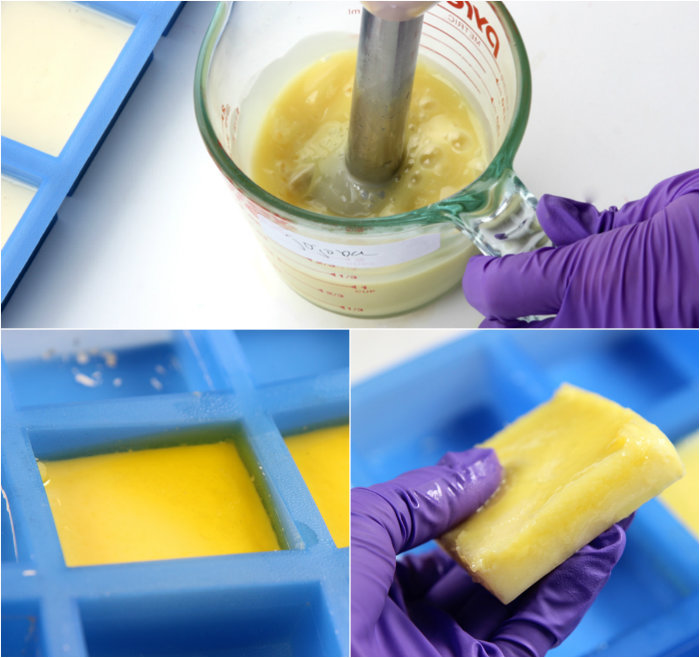 Top: Jojoba oil took quite a bit of stick blending in order to emulsify the oil and lye solution to trace.
Top: Jojoba oil took quite a bit of stick blending in order to emulsify the oil and lye solution to trace.
Bottom left: After sitting in the mold, the jojoba oil separated. Right: Once removed, the solid part of the bar was extremely soft after 6 weeks.
Now, onto the lather tests! To test the soaps, I used lukewarm warm tap water. I got my hands and the soap thoroughly wet and then lathered up. I looked at a few characteristics. First, was the lather fluffy, creamy, slimy, lotion-like, etc? How did the soap feel in my hands, was it firm or very soft? Was the lather stable? A stable lather means the bubbles are long lasting and do not disappear quickly or turn extremely dense. The Bramble Berry office team also tested the twelve bars, and added their notes to mine. Check out my results below.
Olive Oil Pure
-Lather: Small, dense lather. The more I lathered the bar in my hands, the more dense and slightly slimy the lather become. In the second photo, you can see the lather becoming a little sticky.
-Lather Stability: Poor
-Hand Feel: Squeaky clean
Olive Oil Pomace
-Lather: Small and dense lather. Interestingly, the lather was less sticky than the lather of pure olive oil. Instead, it was more creamy and lotion-like.
-Lather Stability: Poor
-Hand Feel: Clean/normal
Coconut Oil
-Lather: Large, fluffy lather.
-Lather Stability: Good. The lather stayed large and fluffy as I continued to use it in my hands.
-Hand Feel: Very squeaky clean and a little dry.
Palm Oil
-Lather: Dense, slightly creamy lather. At first the soap created a few larger fluffier bubbles, but the lather got creamier the more I washed. No stickiness.
-Lather Stability: Poor
-Hand Feel: Squeaky clean
Castor Oil
-Lather: Medium lather. This soap produced some bubbles.
-Lather Stability: Average/poor
-Hand Feel: Squeaky clean
Lard
-Lather: Little to no lather. At first, the bar produced a few very small bubbles. The more I lathered the soap in my hands, the more creamy and lotion-y it became until there were basically no bubbles at all.
-Lather Stability: Poor
-Hand Feel: Normal
Avocado Oil
-Lather: Small, very slimy lather. This may have been one of my least favorite, which is funny because I love avocado oil when used in combination of other oils. The bar hardly lathered at all, but -instead produced a very slimy, snot-like film on the skin.
-Lather Stability: Very poor
-Hand Feel: Slightly greasy, did not rinse clean.
Sweet Almond Oil
-Lather: Large, fluffy lather.
-Lather Stability: Average. After lathering in my hands for a while, the lather did turn more dense and creamy.
-Hand Feel: Normal/soft
Cocoa Butter
-Lather: Dense, but it did actually create some small bubbles! Surprisingly, I found the lather fluffier than 100% palm oil soap. The more I used the soap, the creamier the bubbles became.
-Lather Stability: Average/poor
-Hand Feel: Normal
Shea Butter
-Lather: Very little to no lather. While it didn’t create hardly any bubbles, the lather was not slimy. Instead it was very creamy and lotion-like.
-Lather Stability: Poor
-Hand Feel: Soft/Normal
Avocado Butter
-Lather: Very small and slimy lather. I found the lather to be similar to that of avocado oil.
-Lather Stability: Poor
-Hand Feel: Normal
Jojoba Oil
-Lather: No lather at all. This soap did not produce bubbles. Instead it was very soft, and left a greasy film on the skin.
-Lather Stability: None
-Hand Feel: Left hands feeling very greasy.
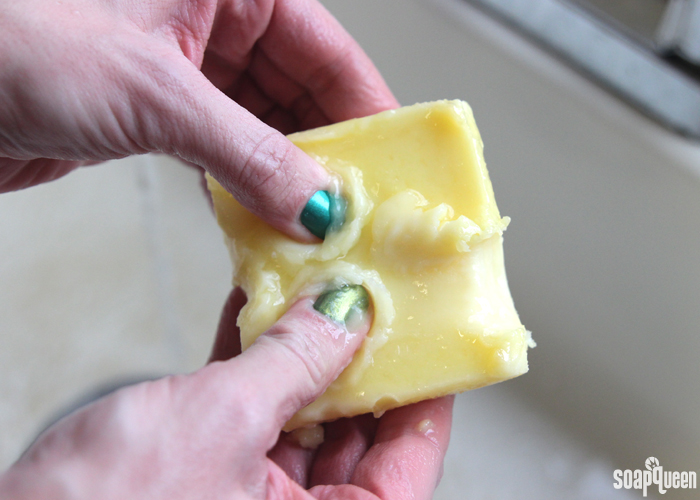
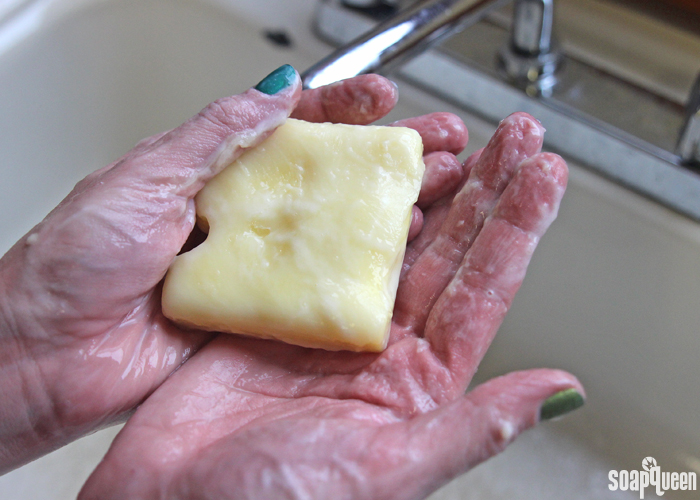
Phew! That was a lot of washing. As you can see, my hands get more and more red and more prune-y with each lather test! =) This experiment did result in some surprises. First, I was surprised that while olive oil and olive oil pomace were very similar, olive oil pomace did product a slightly creamier lather that was not as sticky. I was not surprised that castor oil and coconut oil created the fluffiest bubbles, but I was surprised that cocoa butter soap did actually produce bubbles! I was also surprised that sweet almond oil created such a fluffy lather. Below, you can see the aftermath of lather testing all twelve soaps.
If I had to choose, I would say that my favorite soap was the sweet almond oil soap due to the fluffy lather. My least favorite was the jojoba oil soap which did not lather at all. The office seemed to agree; overall the favorite soaps based on the Bramble Berry office team’s tests was the sweet almond oil soap and the least favorites were jojoba oil and fresh olive oil soap. Many believe that 100% olive oil soap, castile soap, is best after setting and aging 12 months and I agree.
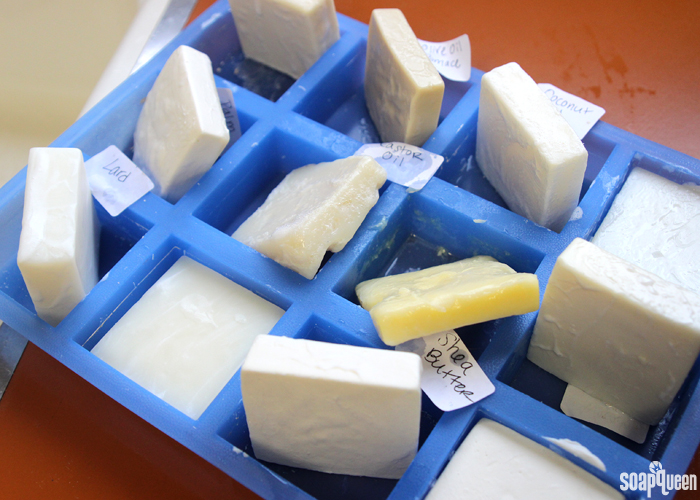
Have you ever made soap with only one oil before. What did you think? Did the results of this test surprise you at all?
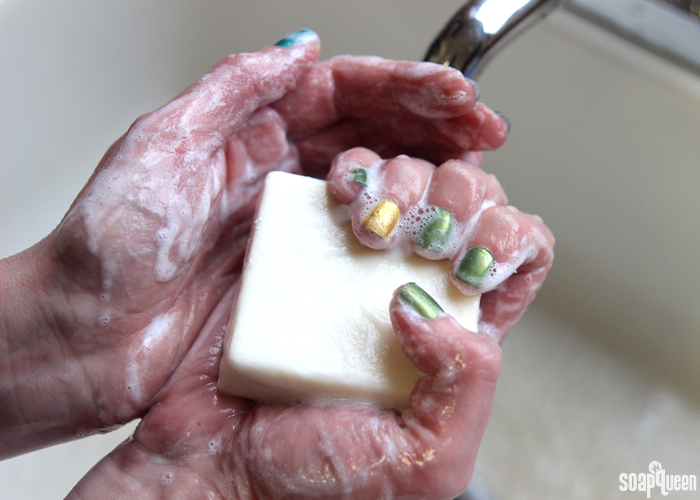
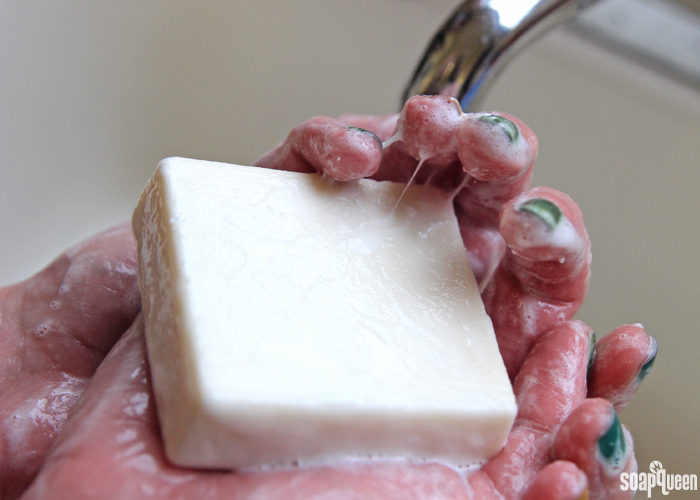
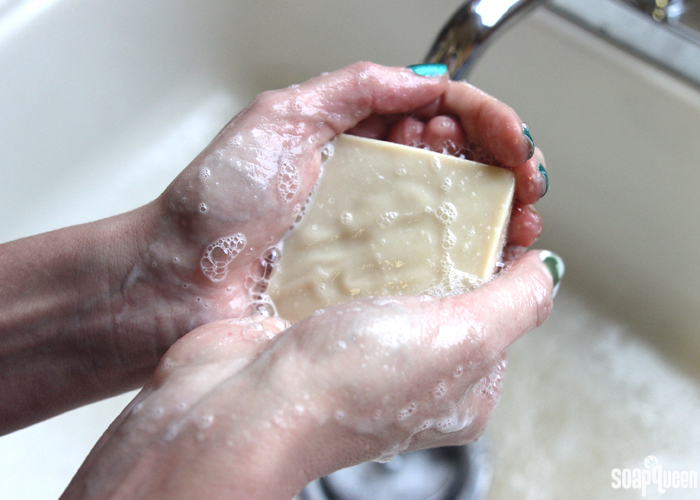
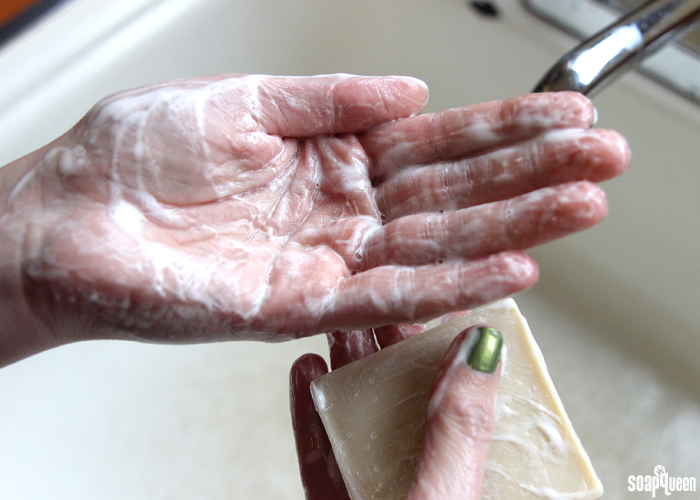
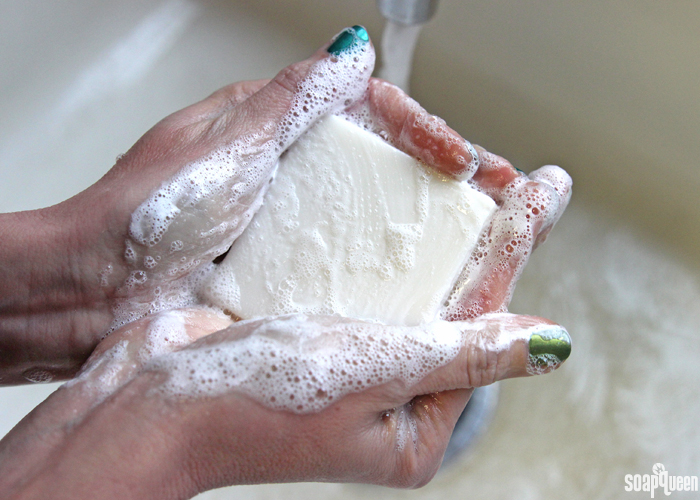
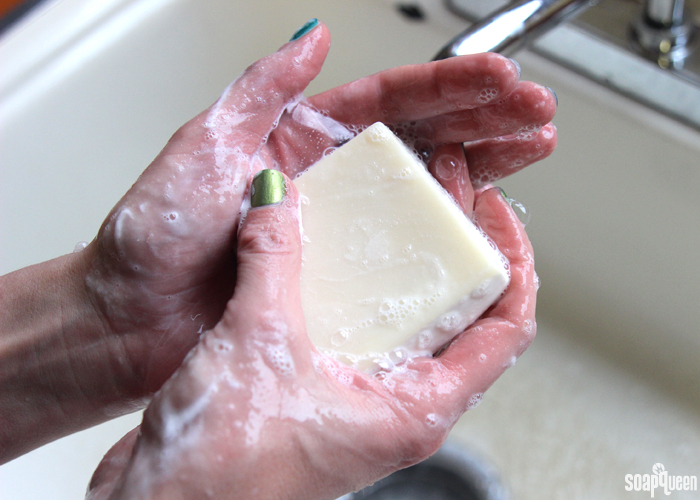
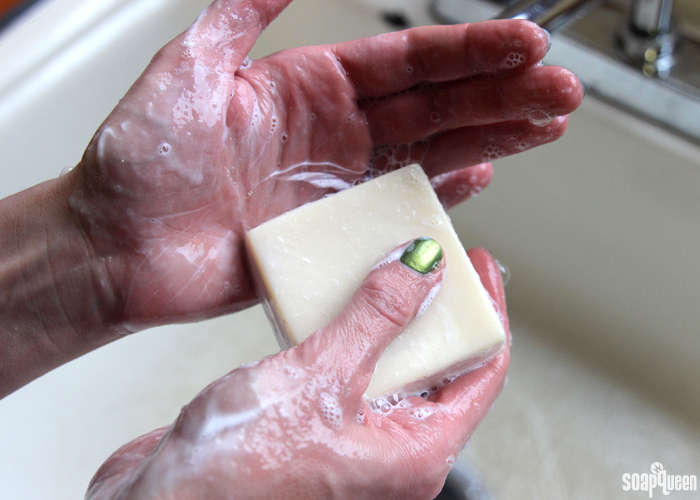
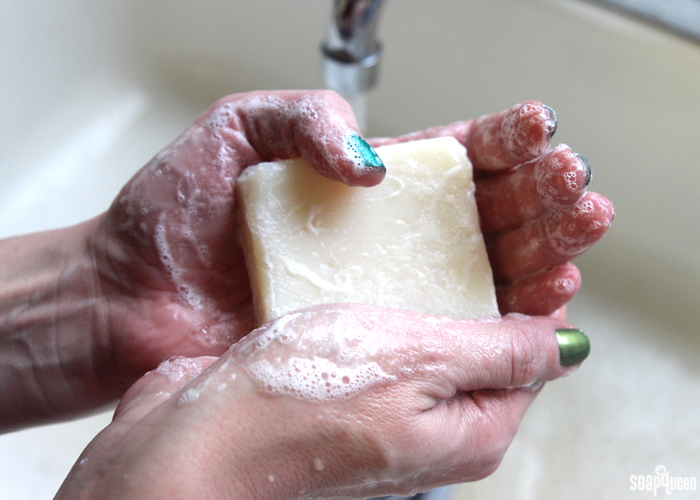
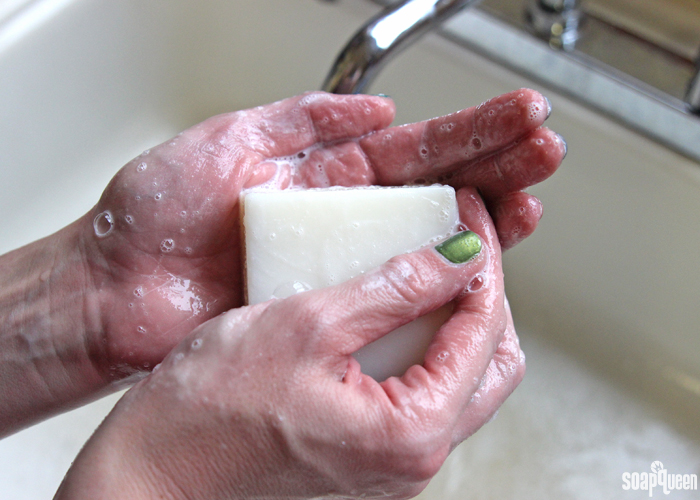
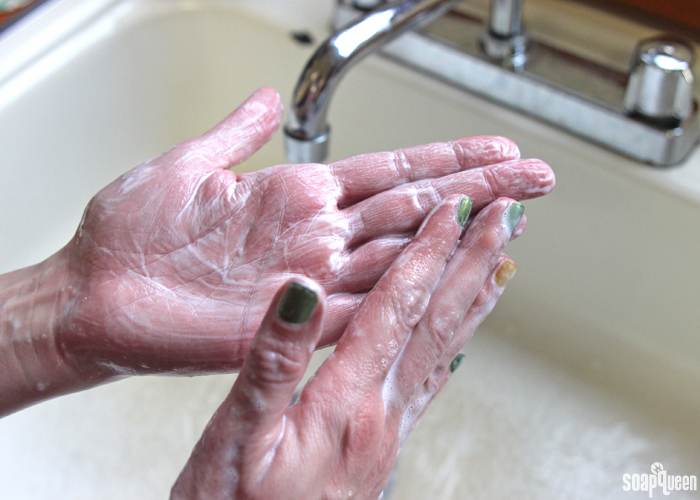
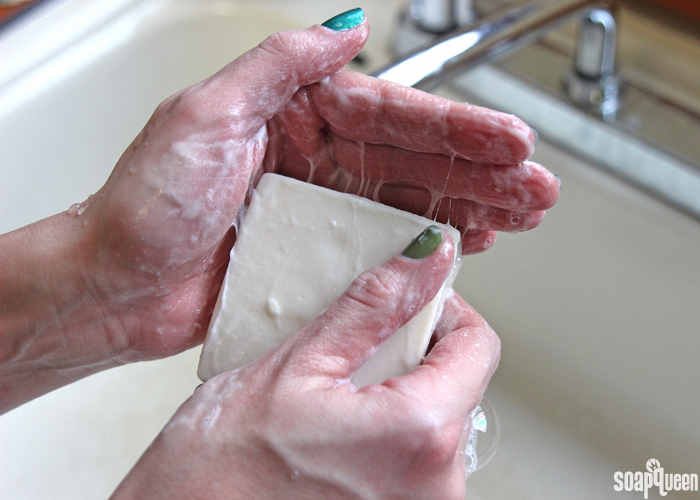
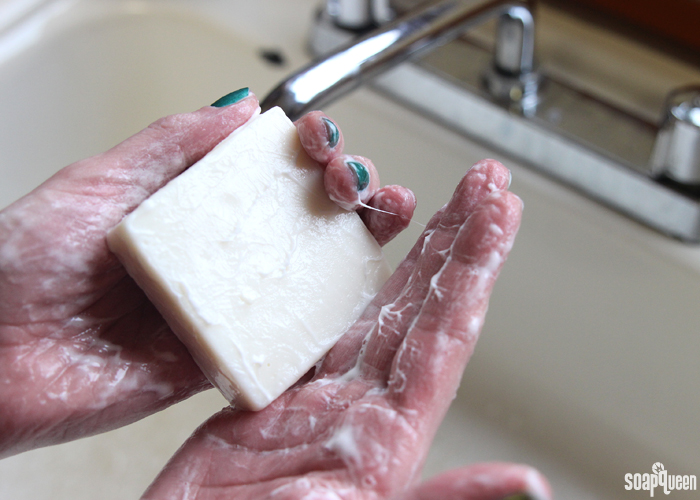
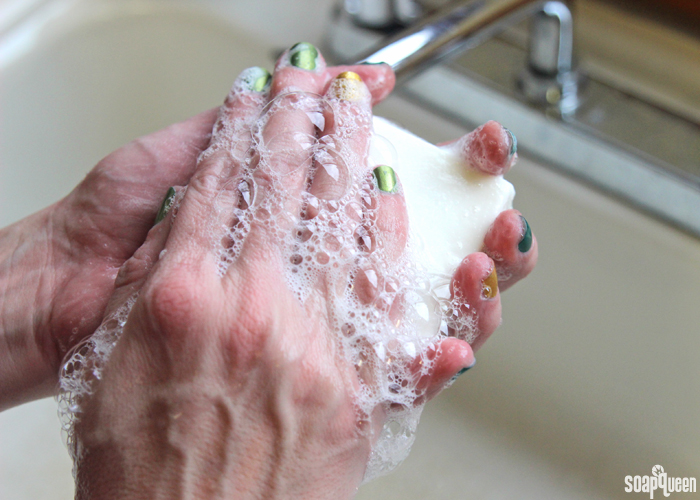
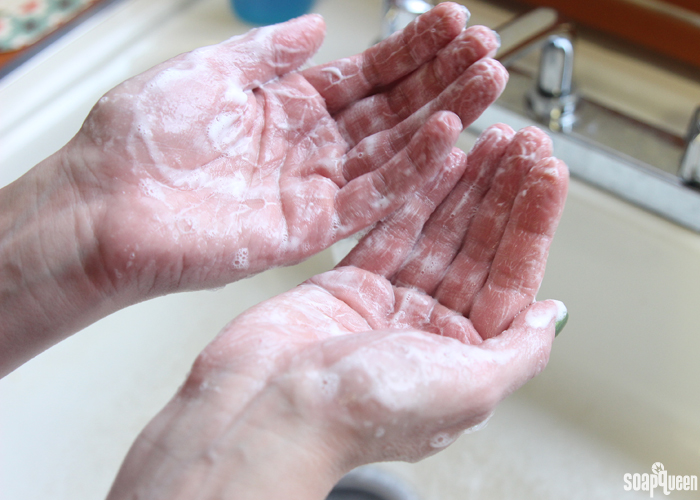
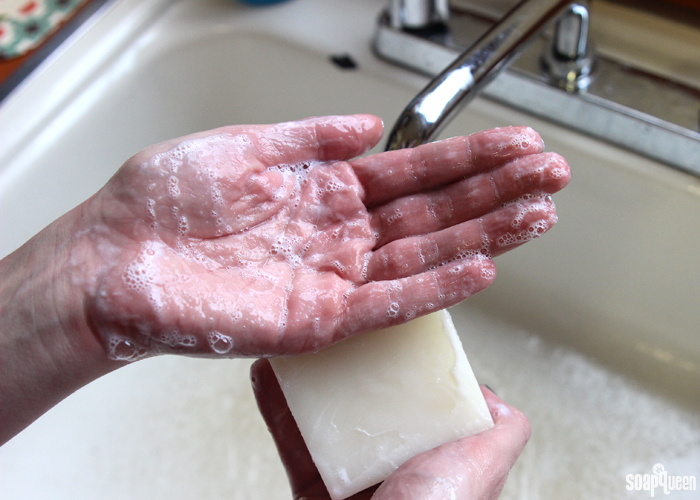
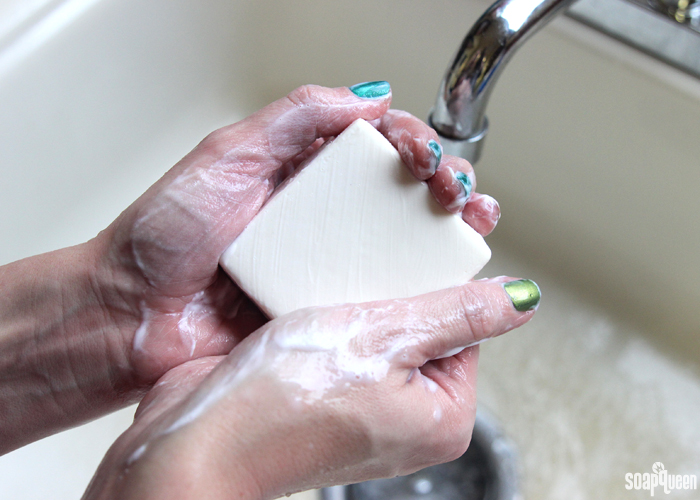
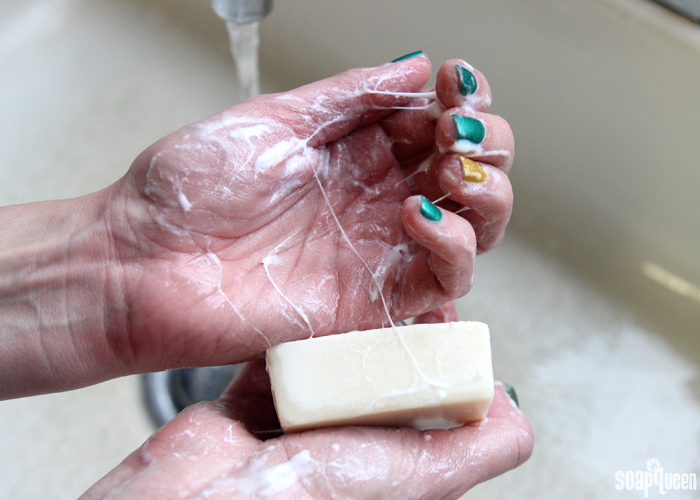




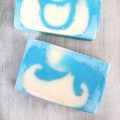
What did you do with all the soaps after you were done? Is there a way to melt them together? Planning to use these recipes for my daughter’s science fair experiment, but don’t know what we’ll do with the bars afterwards, since it seems like the oils make better soaps combined. Thanks for posting your recipes!
Absolutely, you can rebatch all those soaps together: http://www.soapqueen.com/bath-and-body-tutorials/cold-process-soap/soap-queen-tv-presents-how-to-make-rebatch-soap-2/
This was a great article. Is there any way to change this experiment into a hot process soap experiment? My 5th grader would like to do her science fair project with soap. “Which fats make the best soap? ” However, we don’t have a long time to allow it to cure. We are beginning soap makers, so very little experience.
We’ll definitely keep that in mind for future blog posts, thanks for your suggestion.
I want to use Sunflower Oil (because I have a Gallon of it) and little to no other oils. Does anyone have a recipe they can recommend?
You can use sunflower oil up to 100% in a recipe. You can also add other oils to the recipe. For instance, coconut oil helps add firming and cleansing properties. You can add a bit of castor to create lather.
Learn more about common oils and how much to add to your recipe here: http://www.soapqueen.com/bath-and-body-tutorials/tips-and-tricks/free-beginners-guide-to-soapmaking-common-soapmaking-oils/
This post on formulating cold process recipes is helpful as well: http://www.soapqueen.com/bath-and-body-tutorials/tips-and-tricks/formulating-cold-process-recipes/
Used 80% sunflower oil and 20% coconut oil. But after curing for 6 weeks the soap turned out slimy and sticky… What should I do?
With a soap that has a lot of liquid oil, it will naturally be soft. You can let it cure for a few more weeks, that will help it harden up. It will still be softer than a bar made with more hard oils. If you like a harder bar, you can add coconut up to 33%, palm up to 33%, and a butter up to 15%.
Learn more about common oils and how much to add to your recipe here: http://www.soapqueen.com/bath-and-body-tutorials/tips-and-tricks/free-beginners-guide-to-soapmaking-common-soapmaking-oils/
This post on formulating recipes has good information as well: http://www.soapqueen.com/bath-and-body-tutorials/tips-and-tricks/formulating-cold-process-recipes/
Thank you for asking this question! I have a potential customer with severe allergies. Sunflower oil is on her approved list- must go make a test batch to see how it behaves as a singular oil. Good luck with your soaping!
this is an AWESOME post! i am about to dive into a shea butter soap that i think I am going to do at 87% and 13% castor. Coconut oil dries out my skin too much so i am looking for alternatives. thank you for all this legwork!!
You’re welcome Sarah, glad you found the post helpful.
What ingredient should I add to make a cold feel after bathing? I have a friend who requested a soap that will make him feel mentholated after bathing. I was thinking of the menthol candy feeling after bath. Thank you in advance for answering
You may try peppermint essential oil, it has a natural cooling effect. Make sure to only use the recommended amount on our Fragrance Calculator, otherwise it may be irritating on the skin: https://www.brambleberry.com/Pages/Fragrance-Calculator.aspx
Peppermint essential oil: https://www.brambleberry.com/peppermint-essential-oil-2nd-distill-p3832.aspx
-Kelsey with Bramble Berry
Hi, I was thinking about doing my Chemistry project on the cleanliness of different kinds of soaps, with my controlling variable being the oils. How did you determine how much NaOH to use for each soap, and what would happen if I were to use the same exact amount for each oil. It is important that I try to keep all variables the same and should be using the same amount of NaOH for each batch if I want accurate results for what I’m testing.
You can use our Lye Calculator! It tells you how much water and lye to use for each batch: http://www.brambleberry.com/Pages/Lye-Calculator.aspx
Each oil has a different SAP value. That’s the amount of lye needed to saponify 1 gram of oil or butter. So, that means their lye amounts will vary slightly. 🙂
Read more about oil SAP values here: http://www.soapqueen.com/bath-and-body-tutorials/tips-and-tricks/free-beginners-guide-to-soapmaking-common-soapmaking-oils/
-Kelsey with Bramble Berry
Thanks, do you happen to know the morality of the lye that you used?
I don’t, but I do know the molecular weight is 39.99. You can also find out more information in the MSDS for sodium hydroxide. That is available for download on the product page. 🙂
Sodium hydroxide lye: https://www.brambleberry.com/Sodium-Hydroxide-Lye-P3037.aspx
-Kelsey with Bramble Berry
Could someone who is allergic to coconut oil use a coconut oil soap? I would think they could because the oil has been saponified (given no superfat) but I’m not totally sure.
Hi Helen!
If someone is allergic to coconut oil, we recommend avoiding it just to be extra careful! If they have severe allergies it may cause skin irritation. Instead, you can make Castile soap. It’s made with 100% olive oil so it’s gentle on the skin. 🙂
Learn how to make Castile soap here: https://www.soapqueen.com/bath-and-body-tutorials/castile-cold-process-soap-tutorial/
And learn more about soaping with allergies here: https://www.soapqueen.com/bath-and-body-tutorials/tips-and-tricks/soaping-with-allergies-nuts-gluten-more/
-Kelsey with Bramble Berry
I just tried out a small, 2 lb. batch of 100% Coconut Oil* this morning. The first few soaps we cured were over 25-30% CO and made me feel dry, but since we just bought a lot of the oil on sale, I decided to run some experiments with superfatting. It took much longer to trace than I’m used to (no fragrances or colors to speed things up) but setup in just a few hours. I unmolded it after about 5 hours and am about go to cut it. It looks exactly like cold coconut oil, frosty white and hard. I think this evening I’m going to try another batch with pumpkin puree and one with honey – I’m also testing gel techniques.
Speaking of gel, I soaped at around 90F (things seem to go less wrong when everything is cooler) and placed uninsulated in a cold oven. It quickly got up to 150F, bulged and cracked a bit (I was surprised it did that since it was such a small batch) but stayed bright white. Like I said, it finished quite quickly, in just a couple hours it was hard as cured soap.
* about a third of this recipe: https://www.soapqueen.com/bath-and-body-tutorials/cold-process-soap/defying-the-rules-of-soapmaking-100-coconut-oil-soap-with-aloe-vera-and-a-mantra-swirl/
Coconut oil soap does harden very quickly, it’s really nice! We’ve found that superfatting at 20% can help take away some of the drying feeling on the skin. Have fun trying pumpkin and honey. That will add some great lather. 🙂
-Kelsey with Bramble Berry
How to Add Purees to Cold Process Soap: https://www.soapqueen.com/bath-and-body-tutorials/tips-and-tricks/how-to-add-purees-to-cold-process-soap/
How to Use Honey in Bath and Body Products: https://www.soapqueen.com/bath-and-body-tutorials/tips-and-tricks/use-honey-bath-beauty-products/
What an eye-opener! Thanks for sharing all that very interesting information.
A friend of mine, living in a small village in Andalucia (Spain), makes “wondersoap” from used and cleansed olive oil mixed with flour and salt to wash very dirty laundry. Do you think that used and cleansed wheat germ oil or sunflower oil could be used to make soap for laundry? If yes, any idea on how much lye and water to be used? So far, I make 100% coconut oil bars that I shred and mix with washing soda and this gives excellent results. Thanks beforehand for the tips and tricks. Warm regards!
You’re welcome Mia, glad you enjoyed the post! 🙂
I think wheatgerm or sunflower oil would work just fine for laundry soap! They won’t be as cleansing as coconut oil but should work great for regular loads of laundry. You can use our Lye Calculator to find out how much water and lye to add to the batch: https://www.brambleberry.com/Pages/Lye-Calculator.aspx
We haven’t done a lot of experimenting with cleaning used oil, but I imagine it would be similar to rendering tallow or lard! Learn how to do that here: https://www.soapqueen.com/bath-and-body-tutorials/tips-and-tricks/render-lard-home/
-Kelsey with Bramble Berry
I make a 100% coconut oil soap but I superfat it 25% which I know is normally a soaping no no but I promise it makes an amazing bubble filled bar that is not as drying. It is a great seller.
Oh absolutely! The 100% coconut oil soap with a high superfat feels really nice. The lather is incredible. 🙂
-Kelsey with Bramble Berry
And the super duper fatted coconut oil soap make an awesome shampoo bar and shaving soap.
Absolutely! It has such awesome bubbles. 🙂
-Kelsey with Bramble Berry
The first cold process soap I ever made (over 10 years ago) was 100% beef suet which I rendered myself. Although it did not make much of a lather, was probably similar to the lard, it was the creamiest, most soothing soap to use. Several friends had said it was the most soothing soap for their dry skin. And an extremely hard bar.
I recently found a small bar of this in a box of memorabilia I was unpacking when I moved to a new house, and it was still in pretty good shape – not rancid at all – probably because I did not know about super fatting so all the oil must have been saponified.
That sounds like an awesome bar! I love a nice creamy soap. Sometimes the simplest recipes are the best. 🙂
-Kelsey with Bramble Berry
Can you please try with 100% sesame oil? Thank you.
We will definitely keep that in mind! Thank you for the suggestion. 🙂
-Kelsey with Bramble Berry
Wow this was a lovely read! I deeply enjoy the research articles. I love everything you all create. I also just pointed my friend to your molds and entire store when she said she wanted to buy me stuff to support me. Thank you so much for taking the time and the supplies to share this with us. I was curious as to why you decided to do a 0% SF but I need to check to see if that has already been answered on your site somewhere. It was also very helpful for me to see the COLOR of each single oil saponified! I really appreciated that.
I’ve heard from a soaper in South Africa via youtube that 100% pure olive oil will reduce its slime and increase hardness with a much longer cure of at least 6 months or a year and really great at two but then I’m personally concerned about the age of the oil for DOS/rancid soap. I thought it was interesting that the olive pomace had less slime if I remember.
Your sweet almond oil results has me wanting to use that more even with nut allergies.
Ps. I just met someone allergic to coconut and it made me sad for them!
Thank you so much Lisa! Your sweet comment really means a lot to us. Glad you enjoyed this post. 🙂
We kept the soap at 0% superfat so the lather results wouldn’t be affected. Typically, the higher the superfat, the smaller the lather will be. If you’re using the soap to wash with, you may want to superfat to add some luxury to the bar!
Also, curing the olive oil soap for 6 months or more definitely helps. As that soap continues to cure, that slimy feeling will disappear. I’ve found my favorite castile bar is one that has cured for up to a year! Also, olive oil has a pretty long shelf life of 2 years, so it should last even with a long cure time. Read more about 100% olive oil soap here: http://www.soapqueen.com/bramble-berry-news/olive-oil/
And read more about preventing DOS here: http://www.soapqueen.com/bath-and-body-tutorials/tips-and-tricks/dreaded-orange-spots/
-Kelsey with Bramble Berry
Very nice! another great article. I have been wondering how each one of the oils would perform in single oil soaps, and once again I got my questions answered. I found it interesting that the shea butter soap made a creamy “lather”. Mine ended up slimy…. May need to readjust the recipe 🙂
Thanks!!!
You’re welcome, so glad you like the post! Thanks for reading. 🙂
-Kelsey with Bramble Berry
The only time I make 1 oil soap (100% coconut oil) is for the purpose of grating it and turning it to my laundry soap wash. After I cure the soap for about 4-6 weeks I grate a 5oz bar, dissolve in hot water and mix in a 5lb bucket with 1 cup borax, 1 cup washing soda and the rest warm tap water. It works pretty well. Although for white or really dirty clothes I add some Oxi clean to my load. Great experiment and thanks for sharing your findings.
Thanks so much for sharing your recipe Andrea! Coconut oil is awesome for laundry soap. The cleansing properties in the oil work wonders on dirty clothes. 🙂
-Kelsey with Bramble Berry
How does this recipe do in HE washers?
Hi Jenna!
We have several laundry soap recipes we’ve tested in an HE washer and they worked well! I’ll include links below. I would recommend testing the recipes in your washer to see what you think. 🙂
Natural Laundry Soap Recipe: https://www.soapqueen.com/bath-and-body-tutorials/home-crafts/natural-laundry-soap-natural-dryer-sheet-recipe/
Three DIY Laundry Soap Recipes: http://www.soapqueen.com/bath-and-body-tutorials/home-crafts/three-diy-laundry-soap-recipes/
-Kelsey with Bramble Berry
I would love to know how you got castor oil to lather. https://l.facebook.com/l.php?u=https%3A%2F%2Fyoutu.be%2F1l9CX2L2hHk&h=HAQG4nt1u
We were surprised it lathered as well! I’m not entirely sure why. I can only speak for our tests, and we found that 100% castor oil soap made average lather. Less than some of the bars, but also more than some. 🙂
-Kelsey with Bramble Berry
Did you only make one bar of each? It would be interesting after 6 and then 12 months what the result is as Olive Oil especially does require that very long cure time and I wonder if the stickiness etc would be gone by then.
We made two bars of each soap! We are going to let them continue to cure in our lab. We’ll definitely keep another post about how they lather then in mind! 🙂
-Kelsey with Bramble Berry
Awesome!
Hi! I was wondering if you would consider making an entire post on the uses of 100% coconut oil soap for domestic cleaning purposes.
I make this soap (0% superfat) and I’ve been using it around the house for months. I use it to clean the bathroom and I shred it and mix it with washing soda to make laundry soap.
BUT yesterday, I found out that it does wonders to clean stains out of clothes! I am amazed!
I think my next experiment will be a liquid 100% coconut oil domestic soap. Maybe it could also be used to clean floors? And dishes?
Hi Gabrielle!
We will definitely keep that in mind, thank you for the suggestion! Coconut oil is great for cleansing purposes. We absolutely love it in laundry soap. 🙂
Three DIY Laundry Soap Recipes: http://www.soapqueen.com/bath-and-body-tutorials/home-crafts/three-diy-laundry-soap-recipes/
-Kelsey with Bramble Berry
Gabrielle that sounds good. I have been wanting to experiment with liquid soap to replace our current liquid dish soap which I find to be very drying. I would imagine 100% coconut oil would be overly drying as well with constant use. Maybe adding 1-2 more oils wouldn’t hurt if you are wanting to use a high percentage of coconut oil. Just a suggestion. I haven’t experimented with this myself just yet until I purchase an all natural preservative like willow bark extract. Currently researching. Best of luck!
You guys keep outdoing yourselves! Another great informational article. So nice to have you all go through the time and expense of experimenting for us 🙂
Thank you so much Michael, glad you like the post! We had fun testing all the lather. 🙂
-Kelsey with Bramble Berry
Aren’t making single oil soaps fun!? You always learn something new and there are always surprises. Here are the results of some that I made. http://www.lovinsoap.com/single-oil-soaps/
It was really fun for us! Thanks for sharing that link Amanda, can’t wait to check out your results. 🙂
-Kelsey with Bramble Berry
Have you done any testing on 100% Canola Oil, High Oleic?
We haven’t done a 100% oil test with that, but we may in the future! Thanks so much for your suggestion. I do know it’s similar to olive oil. I imagine it would have the same soft feel and small lather. 🙂
Canola oil: https://www.brambleberry.com/Canola-Oil-High-Oleic-P5548.aspx
-Kelsey with Bramble Berry
I was just referring back to this post hoping there was a pure canola test too. I do find myself looking back at this when considering adding a new oil to a recipe.
We’ll definitely keep that in mind Aimee! Thanks for the suggestion. 🙂
-Kelsey with Bramble Berry
Good to know!
Thanks for doing all the testing for us! I was hoping to see a 100% hemp test but guess I’ll try that one myself 😉
You’re welcome Rhiannon! We may be doing more of these tests in the future, so we’ll definitely keep hemp oil in mind. If you give it a try let us know how it feels! 🙂
Hemp seed oil: https://www.brambleberry.com/Hemp-Seed-Oil-Refined-P3209.aspx
-Kelsey with Bramble Berry
Would be interested to see your thoughts on Safflower Oil as it is one I like to use.
We are thinking of doing more tests in the future, so we will definitely keep safflower oil in mind! One of our customers said they tried it and really liked the way it felt. If you give it a try, we’d love to hear your results. 🙂
-Kelsey with Bramble Berry
100% olive oil soap is best when hot processed, or if cold processed, with a water discount instead. The problems I found, and the reason for the long cure time, is the excess water. Once the excess water is controlled either by the cook or by the lesser amount in the beginning, you’ll have a harder bar and gentler soap in a smaller amount of time than 12 months – think weeks – similar to other cold process formulas. And once cooked and/or water discounted it takes only hours to get a hard bar ready to unmold and cut to cure. It isnt drying to the skin, and isnt slimy once the water issue is addressed. While the bubbles may not be big and fluffy, its the feeling of your skin afterwards that matters. I suffer from dry skin and have tried many different formulas to make a bar that doesnt leave my hands feeling like sandpaper afterwards. The only one that has helped my skin has been pure castile soap with no additional oils.
Thank you for the very interesting article!
Thanks so much for the great tips Elaine! Hot processing or water discounting olive oil soap can definitely take away some of the sliminess, and also cuts down on the cure time. 🙂
Read more about water discounting here: http://www.soapqueen.com/bath-and-body-tutorials/tips-and-tricks/water-discounting-cold-process-soap-how-why/
And learn how to hot process soap in this video: https://www.youtube.com/watch?v=mxTXwxbpzLM
-Kelsey with Bramble Berry
Elaine, thanks for your tips on making a better 100% olive cp! May I ask how far you go with the water discount? Thanks!
Hi, I used only soybean oil and I personally love it….except that it is a softer bar, still watching it
That sounds like a good bar! How is the lather? 🙂
-Kelsey with Bramble Berry
Thank you so much for this post! This is something I have always been curious about. Even with different INS numbers, it’s hard to really make a determination until you see it in action. In your opinion, based on your experiment, how do you think a recipe which called for Sweet Almond, Castor, and Coconut do? What ratios would you put them in?
You’re welcome Kristen, glad you found the post helpful!
A sweet almond, castor and coconut oil bar on its own may be a little tricky. We recommend coconut oil up to 33%, sweet almond up to 20% and castor oil up to 5%. That makes up 58% of the bars. What sort of bars do you like – softer, firmer? Do you like creamy soap from butters or luxurious oils? Let me know and I can recommend something to make up for the last 42%. 🙂
You can read about common oils and what properties they add to soap here: http://www.soapqueen.com/bath-and-body-tutorials/tips-and-tricks/free-beginners-guide-to-soapmaking-common-soapmaking-oils/
-Kelsey with Bramble Berry
If it was me, I would try 70% coconut, 20% almond and 10% castor. With 10% superfat. 🙂
Thanks so much for the suggestion Martina! That sounds like a great recipe. 🙂
-Kelsey with Bramble Berry
I made an olive oil soap at the request of a customer, I disliked it, it was very mild but slimy, and did not lather. Took six weeks to cure. Safe to say I won’t ever do it again!
The bars can definitely be a bit soft and slimy! If you get another request, Elaine has some great tips. Hot processing or water discounting the soap can make it more firm and take away some of the slimy feeling. 🙂
Read more about water discounting here: http://www.soapqueen.com/bath-and-body-tutorials/tips-and-tricks/water-discounting-cold-process-soap-how-why/
And learn how to hot process soap in this video: https://www.youtube.com/watch?v=mxTXwxbpzLM
-Kelsey with Bramble Berry
I did a very similar test, though I didn’t test castor, sweet almond or jojoba and I did test tallow. grapeseed and rice bran. On the coconut only, I did a 20% superfat, because everyone was all excited about doing that soap, so I wanted to try it. I thought it was OK, but not any better than my typical balanced bar. What was most interesting has been seeing which bars have developed DOS over time. The grapeseed went off really fast (no surprise there) but the EVOO held up better than the pomace, which surprised me. I liked both the lard and tallow bars, and if I had to to a 100% only bar, it would be tallow. It was surprisingly good all by itself.
That is super interesting, thanks so much for sharing your results Jennifer! I’ll have to give the tallow bars a try. They sound really nice. 🙂
-Kelsey with Bramble Berry
I made single oil soaps in my chemistry of cooking class at Harvey Mudd college: olive, canola, and coconut. The coconut oil soap was very hard but the other two were ok. We all preferred the fourth bar: mix of all 3 oils!
Mixing the oils creates a really nicely balanced bar! I definitely prefer more than one oil in my recipe too. 🙂
-Kelsey with Bramble Berry
I’ve got a batch of pure olive oil castile soap curing currently. It was wonderful to work with, and yes, it took a while to reach trace, but it came out looking a beautiful light color, and the essential oil blend I used in it smells delightful. We’ll see if its ready by summer, or whether I’ll end up waiting the full 12 months as some suggest.
As for the lard, I haven’t used it at 100%, but I did try out a recipe recently where I traded out the majority oil – olive, avocado, lard, etc – and adjusted for the proper lye amount, and so far, the results with it have been the best for swirling I’ve had thus far. I was surprised as well, given the other oils – coconut, palm, and a touch of castor – were generally harder oils, and thought I wouldn’t be able to do much in the way of coloring. It was a pleasant surprise, and I managed to do 2 separatelty-scented batches, with 2 color swirls in with the natural batter each, both poured in the same timeframe. Calculations suggest the lather will be sufficiently bubbly & creamy, but I’ll have to wait until I unmold, cut, and test it out.
That’s awesome! I love when you have lots of time to work with swirls and designs. We were surprised at how slowly lard traced as well. We were expecting it to thicken almost immediately!
-Kelsey with Bramble Berry
Hi, thanks for nice test! One soapmaker here did something like you and she found the cocoa butter soap gets more bubbly after 12 m and even more after 18 months, so older was better. Sweet almond oil has surprised me also! Love it! And jojoba oil seems to be a wonderful superfat for CP soap as it is so hard to saponify. Great to know! I will try it next time!
It would be interesting to let your soaps cure and cure and try it once again after couple of months as well!
Thanks a lot I like it very much!
You’re welcome Petra, glad you enjoy the post! We will keep our soaps up in the lab to continue curing so we can see how they do after more time. 🙂
-Kelsey with Bramble Berry
Hi. Thanks for the great info. I’m curious as to why you decided not to super fat/ used a 0% lye discount? Wasn’t the the soap drying?
Hi Colleen!
We did a 0% superfat so the lather tests wouldn’t be affected. A higher superfat can mean smaller lather. We wanted to see how the soap performed without it.
If you’re making the bars to use or to sell, you can superfat the soap so they’re not too drying. We like to superfat right around 5%. For bars like the 100% coconut oil one, we recommend superfatting at 20% to prevent dryness. 🙂
Read more about superfat here: http://www.soapqueen.com/bath-and-body-tutorials/cold-process-soap/superfatting-soap-an-explanation-2/
You may also like this 100% Coconut Oil Soap: https://www.soapqueen.com/bath-and-body-tutorials/cold-process-soap/defying-the-rules-of-soapmaking-100-coconut-oil-soap-with-aloe-vera-and-a-mantra-swirl/
-Kelsey with Bramble Berry
” For bars like the 100% coconut oil one, we recommend superfatting at 100% to prevent dryness. :)”
A 100% superfat, is that correct or a typo?
It is! I meant 20%. Sorry for any confusion. I updated the comment. 🙂
-Kelsey with Bramble Berry
My very first batch of soap was 100% lard and it was a successful, but very hard bar of soap and I also had a lot of trouble getting it to a thick trace. The soap worked well but took a lot of friction to get any lather and it lasted forever. I eventually grated the last of it to use in the laundry and had to BOIL it in water to get it to dissolve. I discovered my current tried and true recipe that I never deviate from and it only has two oils. Want my secret? 50% olive oil and 50% coconut oil with a heavy superfat over 10%. It sets up nice and firm and plops smoothly out of a silicone mold in 8 to 10 hours and is hard and ready to cut. It makes a fantastic thick dense lather similar to shaving cream and that is the lather I prefer. I use this for every design I make for hot and cold process soaps and I’ve made A LOT of batches.
That sounds like an awesome recipe! I love the way coconut oil feels in soap. I may have to give that recipe a try. Thanks James. 🙂
-Kelsey with Bramble Berry
Love this article! I’ve only made Castile and Seamans Soap. Though I do the Seamans soap at 25% super fat to prevent the over drying of the skin.
Thanks James, so glad you love it! What’s your favorite of the two bars, Castile or Seamans? 🙂
-Kelsey with Bramble Berry
What is Seamans soap?
Thank you!
From what I understand it’s another name for brine soap, or soleseife soap! That’s made with salt water to harden the bar up nicely. We have a recipe for that soap here: https://www.soapqueen.com/bath-and-body-tutorials/cold-process-soap/brine-and-rose-clay-cold-process-soap-soleseife-soap/
-Kelsey with Bramble Berry
That is so cool. Really neat that you did that. Very interesting ! Good Job thank you for all the information. Wonderful. I enjoyed reading it and I am sure I will again tomorrow 🙂
You’re welcome Mechelle! Thanks so much for your sweet comment. 🙂
-Kelsey with Bramble Berry
I made just coconut and loved the lather but it did dry my hands afterwards what could be done to make it better? I love not having to buy so many ingredients and cost.
You can increase the superfat to make the soap a bit less drying! We have an awesome 100% coconut oil soap recipe made with a 20% superfat and aloe vera liquid. It feels great on the skin. 🙂
100% Coconut Oil Soap: https://www.soapqueen.com/bath-and-body-tutorials/cold-process-soap/defying-the-rules-of-soapmaking-100-coconut-oil-soap-with-aloe-vera-and-a-mantra-swirl/
-Kelsey with Bramble Berry
Totally agree! This is my favorite soap, I’m making it for 2 years by now. I found the recipe here: http://candleandsoap.about.com/od/SpecialtySoapRecipes/a/100-Coconut-Oil-Soap-With-20-Superfat.htm
I’ve also tried 100% olive oil and it was a mess: very slow to trace and poor lather after 6 months cure.
Very interesting and useful experiment, Soap Queen! Thank you.
The recipe looks awesome, thank you for sharing! Also, so glad you enjoyed the blog. 🙂
-Kelsey with Bramble Berry
Very Interesting!!! Thanks for publishing this info & doing the hard work for all of us! 🙂
You’re welcome Janet, glad you enjoy the post! 🙂
-Kelsey with Bramble Berry
I once made a 100% soybean oil soap, but I did use soy milk in place of the water. It made a very nice hard bar with a medium creamy lather. It was a great conditioning bar.
Oh that sounds awesome, very nice and creamy! 🙂
-Kelsey with Bramble Berry